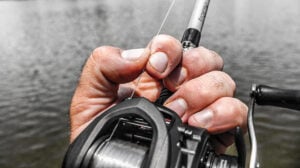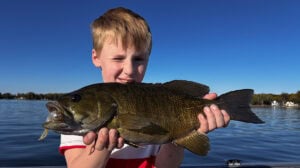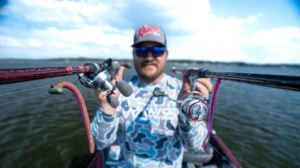Throwing a topwater popper is one of the most addictive and adrenaline filled ways to catch a bass. Watching a fish shoot up from the depths and explode on your lure is a feeling that’s hard to describe. This bite is not only insanely fun, but can also be a super productive way to catch some giant bass during the heat of summer.
One of the best times to get on a good topwater bite here in the south is during the summer months. This time of year the fish have all finished up spawning and are solely focused on finding food. You can catch fish both deep and shallow on a topwater, however my favorite places to throw this bait are often related to the bank. While a topwater popper is a great bait to throw throughout the summer, there are several nuances to look for that can lead to some fantastic days of fishing on this bait.
CHOOSING THE RIGHT POPPER
When throwing a topwater popper, I like to use ones in the 2 to 3-inch range. These sizes will cover the majority of situation you may encounter while throwing a popper. I also like to keep my color patterns simple as well. I typically use either a white or black popper depending on the type of forage I’m trying to imitate. I will occasionally opt for a more detailed color pattern when fishing in super clear water, however for me white or black has historically done the trick.
When imitating smaller sized baitfish, I like to use the smaller sized Lobina Rico Popper, however if I am imitating larger sized baitfish such as bluegill, I will opt for the larger Lobina Rio Rico Popper. These two poppers are great choices for imitating any type of forage you may encounter while throwing this lure.
Also, check out our article on the best topwater lures to find more recommendations.
WHEN TO THROW A POPPER
Throwing a topwater popper is a great way to catch bass all summer long. Once the water reaches over 70 degrees, I’m never scared to pick up a topwater lure and throw it around. While a topwater is a great choice anytime the water is hot, there are a few key scenarios I look for when trying to locate a good popper bite. One of the most productive ways to catch a ton of fish on a popper is during a mayfly hatch.
If you go out on the water and notice tons of mayflies all over docks, overhangs or laydowns, this is a tell-tale sign there is a mayfly hatch going on in your area . These mayflies often fall into the water causing bluegill to congregate and feed on this easy meal. Bass will often hang close by in hopes of feeding on one of these distracted bluegill. This is the perfect time to throw a popper in order to imitate these feeding baitfish.
One of the best days I’ve ever had throwing a topwater popper was on one of my favorite local lakes in Knoxville, Tenn. I went out for a few hours first thing in the morning and noticed there were tons of mayflies hatching down a stretch of docks. I could see bluegill coming up to feed on these insects as they fell down onto the water. I then went down this stretch of docks throwing a topwater popper around the edges of docks and into the boat slips. I fished this stretch for around 45 minutes and ended up catching over 20 bass off this one stretch alone.
This congregation of forage often causes bass to group up. This allows you to catch a ton of fish in a really short amount of time. A topwater popper perfectly imitates bait fish coming up to feed on insects, which makes it the perfect tool to catch bass looking for an easy meal. While mayfly hatches can be a great place to catch a ton of fish, there are several of other types of cover that can be a great choice for throwing this bait.
WHERE TO THROW A POPPER
One of the main things I like to look for when throwing a popper is bluegill. This time of year fish are often keyed in on bluegill or other types of shallow baitfish. This is the main thing I look for when searching for a good popper bite. There are a few key pieces of cover these fish like to hold on this time of year, but one thing they all have in common is shade.
When the water starts to get really hot, fish love to hold out in the shade in search of cooler more comfortable water. This is one of the most productive types of cover this time of year. Bluegill tend to congregate in the shade under docks and overhands in search of protection and forage. This is a great place to throw a topwater popper in order to imitate a bluegill feeding in shaded cover.
Overhangs tend to be a great place to locate bass feeding on bluegill in the summer months. I have found that overhangs on steep channel swing banks tend to hold the most bass this time of year. This steep bank allows fish to easily switch between deep and shallow water depending on their mood. Bluegill often sit under these overhangs in search of insects or other types of forage that fall out of the limbs and create an easy meal. I like to skip my popper all the way to the back of the shade, and slowly work it back to the boat implementing long pauses allowing the bass to locate the lure from a long ways away.
Another piece of structure that can be really productive this time of year is shallow vegetation. When the water gets super hot, fish often move off of harder cover such as wood or rock in search of more comfortable water. This vegetation often provides much cleaner and cooler water which is ideal for bass during the hot summer months. Bluegill often tend to congregate in these areas as well in search of forage that are using this grass as protection.
Going down these grass stretches targeting isolated grass clumps or big holes in the grass can be a great way to produce some quality bites this time of year. Fish will often hide out in the grass, waiting on on easy meal such as a bluegill or shad to expose itself. A topwater popper is a great way to imitate the differing types of forage that use this vegetation as cover. While knowing what to target with a popper is important, having the right setup can be the difference maker in getting those fish to the boat.
BEST SETUPS FOR A POPPER
When throwing a topwater popper, I generally stick with two different setups. When fishing around thick cover such as grass or wood, I like to use a heavier set casting rod and decent sized braided line. However, when I am fishing in open water or under overhangs where I need to skip the lure, I tend to use a spinning setup with lighter line.
For my spinning rod setup I like a shorter rod with a medium action. This shorter rod allows you to skip the bait easier and make far more accurate casts as opposed to a longer more cumbersome rod. This medium action gives you enough power to control the fish during the fight, while not being too heavy causing you to rip the hook out of the fish’es mouth. My go to rod for this setup is a 7-foot medium action Dobyns Champion XP.
For a reel, I like one with a smaller spool and a faster gear ratio. This smaller spool allows the reel to be much lighter and far more comfortable than a larger sized reel. This allows you to make more accurate casts when casting around tight cover. My go to reel for this setup is a Daiwa Tatula MQ LT 2500.
For my casting setup, I like to stick with a medium action rod and a high gear ratio reel. I like a medium rod because it allows you to accurately cast such a small bait, while still being powerful enough to control fish around thick cover. I also prefer a shorter rod for more accurate casts since your often casting around overhangs or other types of cover. My go to rod for this setup is a Daiwa Tatula 7-foot medium action.
For a reel, I like one with a medium sized spool and a fast gear ratio. I like this slightly larger spool because I tend to up my line size when fishing a popper on a casting rod. When throwing a popper on a spinning setup, I generally stick with 15-pound braided line to a 12-pound leader. However, when I am throwing this lure on a casting rod I generally upgrade to 30-pound braid with a 15-pound leader. This allows for a little more control over the fish around heavy cover, especially when throwing a larger sized popper. My go to reel for this setup is a Shimano Curado MGL 150 in the 7:1 gear ratio.
Throwing a topwater popper is a great way to get someone into fishing due to its exciting nature and violent blowups. It is also a great way to catch a ton of quality fish during the heat of summer. These tips will help you go out and catch bass on a topwater popper on your favorite local body of water.














